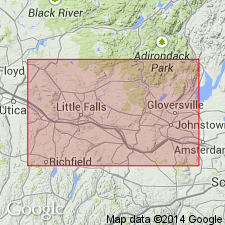
- Usage in publication:
-
- Flat Creek Member
- Modifications:
-
- Named
- Dominant lithology:
-
- Shale
- AAPG geologic province:
-
- Appalachian basin
Summary:
The Utica Shale is divided in the Mohawk Valley into upper and lower parts by a tongue of the Dolgeville Formation and these parts are here assigned member names. The lower portion of the Utica is named the Flat Creek Member and the upper, the Indian Castle Member. These lithostratigraphic units, both consisting of black shale [but otherwise not described], replace earlier names such as the Canajoharie Shale, which were primarily biostratigraphic. At Flat Creek, the type locality, the lower member rests disconformably on Glens Falls Limestone of the lower Trenton Group and is laterally equivalent to a portion of the lower Trenton above the level of the Glens Falls. Contact with the overlying Dolgeville is gradational and at the type locality it is placed 88 m above the base of the member where ribbon limestones reach 20 percent of the unit's thickness. East of the basin-ward limit of the Dolgeville (at Canajoharie Creek), the Utica is undivided. The Flat Creek Member (or lower Utica) extends westward to East Canada Creek where it overlies and interfingers with the Sugar River Limestone. Age is Middle Ordovician (Kirkfieldian and Shermanian) based on graptolites and K-bentonites.
Source: GNU records (USGS DDS-6; Reston GNULEX).
For more information, please contact Nancy Stamm, Geologic Names Committee Secretary.
Asterisk (*) indicates published by U.S. Geological Survey authors.
"No current usage" (†) implies that a name has been abandoned or has fallen into disuse. Former usage and, if known, replacement name given in parentheses ( ).
Slash (/) indicates name conflicts with nomenclatural guidelines (CSN, 1933; ACSN, 1961, 1970; NACSN, 1983, 2005, 2021). May be explained within brackets ([ ]).

